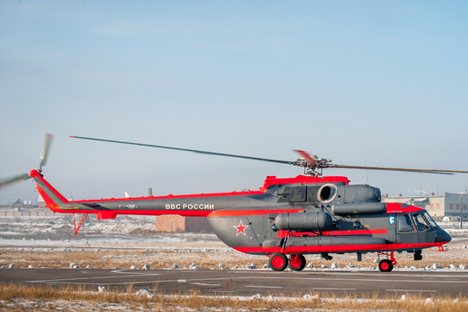‘Terminator’ on ice: 10 facts about Russia’s new Arctic helicopter

Flight tests of the Mil Mi-8AMTSH-VA Arctic helicopter in Ulan-Ude.
Ria Novosti/Mark Agnor1. The unofficial name of the Mi-8AMTSh-VA is ‘Terminator.’
The new aircraft is based on military transport helicopter Mi-8AMTSh (export name – Mi-171SH). Unlike the base model, this helicopter is equipped with new Klimov VK-2500-03 gas-turbine engines, a more powerful TA-14 auxiliary power unit, and upgraded avionics. The new Mi-8AMTSh VA Terminator set a new milestone – it became the 1,000th helicopter produced by the Ulan-Ude Aviation Plant.
2. The helicopter was specially designed to work in the Arctic
It can operate at low temperatures, during polar nights, over hard-to-navigate featureless terrain, with unstable radio communications, over wide distances between operational bases, and long flights over water.
3. Mi-8AMTSh VA – a rescue craft and intelligence gatherer
The helicopter is designed for landing operations, providing support from the air and the evacuation of special operations groups, aerial reconnaissance and targeting, transport and landing, ambulance services for Arctic military forces, as well as search and rescue support for security forces, including in the areas of the Northern Sea Route.
4. The helicopter is painted in a non-standard color scheme
In contrast to the use of camouflage coloring on most helicopters used by the Russian Defense Ministry, this Arctic helicopter is covered with special spectacular reflective dark-gray and bright-red paint, which makes the helicopter stand out as much as possible in the endless snow or dull landscape of the tundra.
5. Aircraft technologies were used in the production of the Arctic helicopter
The longitudinal structural elements of the Mi-8AMTSh VA are not riveted, as is done in most conventional helicopters, but welded. The welds improve the aerodynamics of the helicopter and are easier to repair in the “field conditions” of the far north.
6. The helicopter’s maximum range without landing is more than 800 miles
This range, which is around 150 miles more than that of the standard model, is possible due to two additional fuel tanks on the external sling and two additional internal fuel tanks.
7. The Mi-8AMTSh-VA can safely navigate and fly even with the loss of satellite signals
Thanks to the digital autopilot, the navigational accuracy and efficiency of piloting the helicopter have been increased over hard-to-navigate featureless terrain and during the polar nights of the Arctic. In addition, this craft is equipped with a redundant satellite system, a digital navigation system with a built-in map generator and a strap-down inertial reference unit, which allows the helicopter’s crew to determine their current coordinates, even in the absence of satellite signals.
8. The helicopter is supplied with equipment that allows it to operate effectively at temperatures below –40⁰ Fahrenheit (–40⁰C)
The helicopter is equipped with a TA-14 auxiliary power unit, which operates on the ground and ensures the pre-flight preparation of avionics, the functioning of the kerosene heater (for heating the helicopter’s cabin), the heating of the transmission equipment and power plant systems, the operation of the equipment for heating in-flight food packets and the water boiler.
A combination of standard and additional insulation of the cargo compartment, as well as the installation of thermal insulation curtains, reduces heat loss in the cargo compartment.
9. A non-military version of the Mi-8AMTSh will also be produced
First of all, it will be developed for offshore operations (passenger and cargo transportation). The Russian Ministry of Emergencies and oil and gas companies are interested in using the civilian version of this helicopter in the Arctic regions of the Russian Federation. In addition, a number of other countries (such as Argentina, which conducts research in Antarctica) may be interested in purchasing the helicopter.
10. A stylized image of a polar bear appears next to the helicopter’s cockpit
The brown bear is a traditional symbol of the Ulan-Ude Aviation Plant, and this image appears on all machinery when it first takes off from the plant’s platform. In the case of the Mi-8AMTSh, this bear has changed its traditional color and become white, in a nod to the special Arctic functions of the helicopter.
Read more: New generations of satellites are Russia’s cosmic eyes and ears>>>
All rights reserved by Rossiyskaya Gazeta.
Subscribe
to our newsletter!
Get the week's best stories straight to your inbox

